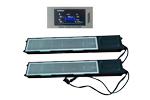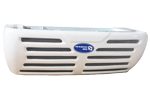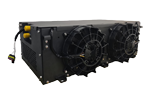System Composition of the Electric Air Conditioning in Electric Buses
The electric air conditioning system in electric buses is a sophisticated yet integral part of the vehicle, designed to provide comfortable temperatures for passengers while maintaining energy efficiency. The system is composed of several key components that work in harmony to achieve this goal. Below is a detailed breakdown of the system's composition:
1. Compressor
- Type: Electric Variable Speed Compressor
- Function: The compressor is the heart of the air conditioning system, responsible for compressing and circulating the refrigerant. In electric buses, it is typically powered by the vehicle's battery, ensuring quiet and efficient operation.
2. Condenser
- Function: The condenser serves to reject heat from the refrigerant, transforming it from a high-pressure gas into a high-pressure liquid. It typically utilizes the vehicle's external airflow to facilitate heat dissipation.
3. Evaporator
- Function: Located inside the passenger compartment, the evaporator absorbs heat from the surrounding air, causing it to cool. As the refrigerant evaporates, it removes heat from the air, which is then circulated throughout the cabin by the fan.
4. Expansion Valve/Throttle Valve
- Function: The expansion valve or throttle valve regulates the flow of refrigerant entering the evaporator. By reducing the pressure of the refrigerant, it facilitates the evaporation process, thereby controlling the cooling capacity of the system.
5. Refrigerant Circulation Loop
- Components: Connecting the compressor, condenser, evaporator, and expansion valve, the refrigerant circulation loop forms a closed system where the refrigerant circulates continuously.
6. Fans and Blowers
- Interior Fan/Blower: Circulates the cooled air throughout the passenger compartment, ensuring even distribution.
- Condenser Fan: Enhances heat dissipation from the condenser, improving the system's cooling efficiency.
7. Electrical and Control Components
- Inverters: May be used to convert DC power from the battery into AC power for the compressor.
- Control Unit: Manages the operation of the air conditioning system, including compressor speed, fan speeds, and refrigerant flow, based on inputs from temperature sensors and user settings.
8. Additional Features
- Heat Pump Functionality: Some electric bus air conditioning systems incorporate heat pump technology, allowing them to switch between cooling and heating modes by reversing the flow of refrigerant. This enhances the system's versatility and energy efficiency.
- PTC Heaters: Positive Temperature Coefficient (PTC) heaters may be used as auxiliary heating elements, particularly in cold climates, to supplement the heat pump's heating capabilities.
9. Energy Management and Efficiency
- The system is designed to operate efficiently, minimizing energy consumption from the vehicle's battery. Advanced control algorithms optimize compressor speed, fan speeds, and refrigerant flow based on real-time conditions and user inputs.
In summary, the electric air conditioning system in electric buses is a comprehensive setup comprising a compressor, condenser, evaporator, expansion valve, refrigerant circulation loop, fans and blowers, electrical and control components, additional features such as heat pump functionality and PTC heaters, and energy management strategies. This integrated system ensures comfortable temperatures for passengers while maintaining energy efficiency and minimizing the impact on the vehicle's driving range.









.png)






